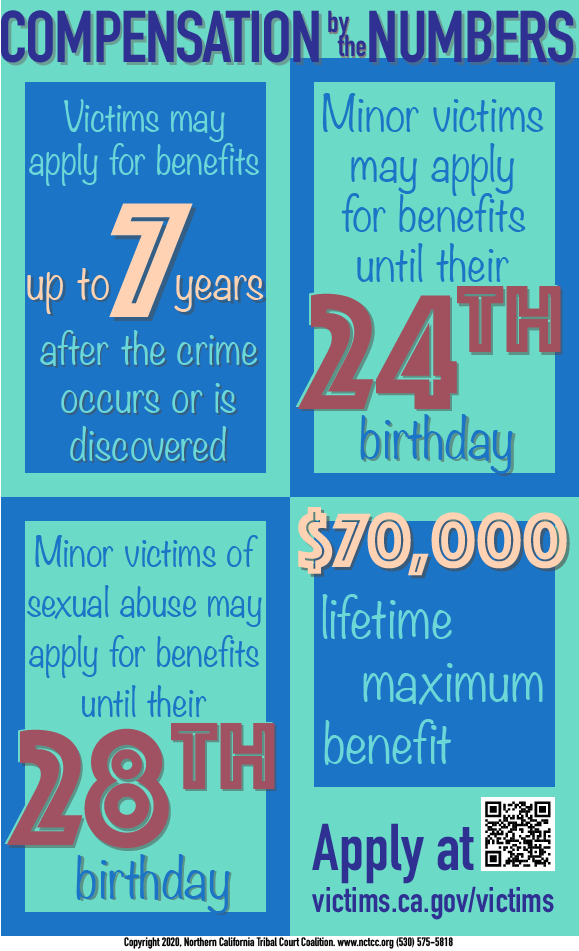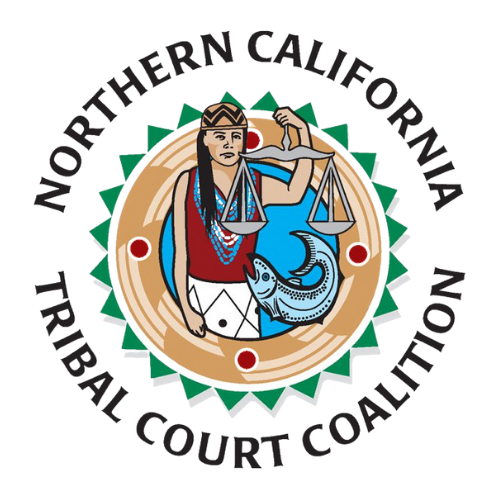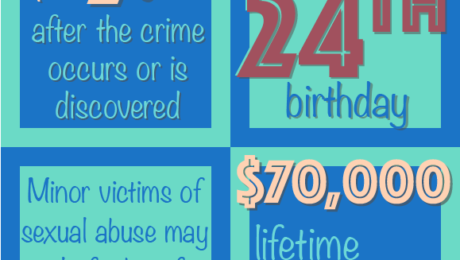An Overview of California Victims’ Compensation
The California Victim Compensation Board (CalVCB) provides compensation for victims of violent crime, including victims of domestic violence and DUI crimes. This article is the first in a multi-part series about CalVCB for Domestic Violence (DV) advocates, DV victims, their families, and their communities. This article focuses on domestic violence victims. However, please keep in mind that benefits are available to victims of any violent crime.
Tribal victims of domestic violence often face more obstacles and greater difficulty overcoming the obstacles than non-tribal victims. CalVCB is a state agency that connects victims of violent crime with financial assistance. While financial assistance does not eliminate all the difficulties that confront DV victims, economic assistance can help minimize the obstacles that victims encounter. In this way, CalVCB is a resource that can help victims achieve positive outcomes.
PART 1: An Overview of California Victim Compensation
Victims of violent crime and their family members can apply for financial compensation for physical injury, threatened physical injury, emotional trauma, and psychological trauma. You have up to seven years after the crime was committed or discovered to apply for financial benefits. DV Advocates can help you apply for CalVCB compensation, or you can appoint a representative to assist with filing your application. Even if you think you do not need compensation right now, you should consider submitting an application so that future complications and out of pocket expenses can be compensated.
Find more information here.
Qualifying crimes
A crime is considered “violent” if it involves physical injury, threat of physical injury, psychological trauma, or emotional trauma. If you have experienced any of these types of violence, you may qualify for compensation. The following list of crimes are those that CalVCB typically covers.
- Domestic violence
- Child abuse
- Child sexual assault
- Child endangerment and abandonment
- Assault with a deadly weapon
- Battery (when there is injury or threat of injury)
- Driving under the influence
- Elder abuse
- Hate crimes
- Homicide
- Human trafficking
- Hit and run
- Vehicular manslaughter
- Murder
- Robbery
- Sexual assault
- Stalking
- Sexual battery
- Unlawful sexual intercourse (where there is injury or threat of injury)
- Terrorism
- Online harassment
- Other crimes that result in physical injury or a threat of physical injury to the victim
If you or a family member has been a victim of a crime that is not on this list but suffered physical injury, threat of physical injury, or emotional trauma as a direct result, you may qualify for benefits. If you have a question about whether a crime qualifies for compensation, you may call the CalVCB helpline at (800) 777-9229 or email at info@victims.ca.gov.
Find more information here.
Qualifying applicants
Applicants who may apply for compensation include:
- Direct victims of violent crime, including minor children.
- The family members and individuals who have or had close, intimate relationships with victims.
- Children who witness violent crime.
- Applicants must not have been involved in or committed a felony in the events leading to the crime.
Find more information here.
Qualifying expenses
CalVCB covers expenses that are directly related to the violent crime that caused your injury. Typical expenses include:
- Medical and dental treatment
- Mental health care including Telehealth
- Complementary and alternative medicine
- Funeral/burial expenses
- Medically necessary equipment
- Home or vehicle modifications
- Home security
- Relocation (moving) expenses
Find more information here.
- Income loss for direct victims and for parents/legal guardians of a minor who is hospitalized or dies
- Support loss for victims’ legal dependents
- Job retraining
- Crime scene clean-up
- Benefits for good samaritans
- Guide, signal, or service dogs
Qualifying application period
To qualify for CalVCB benefits, you must apply before the time limit has passed. Beginning in January 2020 the time limit for submitting an application has been increased from three to seven years. In some circumstances the application deadline can be extended.
For minor victims, a different time limit applies. Minor victims may apply any time before their 24th birthday. For minor victims of sexual abuse, the deadline to apply is the victim’s 28th birthday.
Find more information here.

Documentation needed for your application
To document that you are a victim of a violent crime, you should expect to provide a law enforcement report or other verification. This can include a crime report, child or adult protective services report, copy of a petition for a restraining order (an order signed by a judge does not contains insufficient information; you will need to show the petition), medical and/or mental health records, affidavit from a human trafficking case worker, sexual assault examination report, Title IX campus report, battered women’s program paperwork, or a credible witness statement. Other documentation is evaluated on a case-by-case basis.
To document your expenses, you can expect to provide CalVCB with copies of crime-related bills, receipts, insurance, medical costs, mileage records, lost wages, funeral costs, relocation expenses (Lease Agreement, CalVCB Rental Verification Form, or Landlord’s W-9 Form) and any other expenses directly related to the crime.
To show other potential sources of coverage, you should expect CalVCB to ask you for insurance policy information and any other resources that can be used to pay your crime-related expenses.
Find more information about reimbursable expenses here.
Victims can apply online, however, accessing the application form prior to filing online can help you anticipate the information you will need to provide. PDF versions of the application are available in English, Spanish, or another language.
Learn more about qualifying for CalVCB benefits
CalVCB offers e-learning courses for victims of crime, family and friends of victims, the general public, service providers, helping professionals, advocates, and law enforcement. You can access training at victims.ca.gov/training/ and learn more about CalVCB here.
Assistance for tribal members
CalVCB has several ways in which it can assist tribal members who are victims of violent crime, including domestic violence.
First, tribal members are classified as California residents for eligibility determination purposes, even when the victim is a resident of a Reservation or Rancheria in California. Because tribal members are considered California residents they are eligible for compensation wherever the crime was committed. Also, for the purpose of determining whether a crime was committed in California, if a crime occurs in a California tribe’s jurisdiction, it is committed “inside California.” This eliminates the jurisdictional barrier some victims would otherwise encounter.
Second, CalVCB attempts to provide culturally sensitive services to tribal members. This means that tribal victims can receive reimbursement for a wide range of crime-related expenses including those that may be incurred to support a tribal victim’s lifeways. For instance, in addition to expenses such as medical costs, mental health treatment, relocation expenses, and loss of income CalVCB may also reimburse ceremonial costs, complementary and alternative medicine services, and in some cases can provide emergency financial assistance within 30 days.
Find information about CalVCB services for tribal communities here.
How to apply
Victims of domestic violence are eligible for CalVCB benefits because domestic violence is, by definition, a crime of violence. When a tribal member is victimized, applying for benefits to cover financial expenses can make the difference and help the healing begin.
You can apply for benefits using the CalVCB online application form or download a printable form here.
In Part 2 we will take a closer look at the CalVCB application.
Find a Victim Advocate and other resources with the NCTCC App
You can find a Victim Advocate, community organization, and other helpful resources using NCTCC’s mobile App. Download the App here.

Do you need assistance with downloading or using the NCTCC App? Reach out to us for technical assistance, to arrange a training, or ask questions about this article. Our Program Specialists are here to help. Contact Cynthia Boshell at cboshell@nctcc.org or Jake Swamp at jswamp@nctcc.org.
- Published in Uncategorized
California Victims’ Bill of Rights
April 19 – 25, 2020 is National Crime Victims’ Rights Week
Why victim rights are important for Native people
Over 80 percent of American Indian and Alaska Native women and men have experienced violence in their lifetime, according to a 2016 study by the National Institute of Justice. 97 percent of women and 90 percent of men reported that at least one incident of violence was committed by a non-native person.
Native people frequently experience intergenerational trauma due to colonial violence and historical injustices. When a perpetrator commits a violent crime against a native person, retraumatization can occur. This is often manifested as feelings of helplessness, vulnerability, anxiety, and chronic stress. Diseases that can be triggered or aggravated include cardiovascular disease, arthritis, diabetes, respiratory and digestive disorders, chronic pain, insomnia, and loss of reproductive function. Enforceable victim rights are especially important for American Indians and Alaska Natives to reduce the likelihood that the investigation and prosecution of perpetrators will inflict additional on native victims. Unlike the dehumanizing experiences of historical wrongs, California Victims’ Bill of Rights can protect the dignity, safety, confidentiality, and property of victims, including native people, who experience violence.
A summary of the California Victims’ Bill of Rights
The Victims’ Bill of Rights are part of the California Constitution, Article I, Section 28(b). Also known as Marsy’s Law, it contains a list of 17 specific rights that are intended to protect victims through all phases of the legal process. We have categorized these rights into nine categories as follows:
Human rights and personal dignity
This section provides both positive and negative rights. Positive rights identify the treatment to which you are entitled: fairness, respect for your privacy, and dignity. Negative rights entitle you to be free from certain treatment: intimidation, harassment, and abuse. Section 28(b)(1).
Safety
Three provisions address safety of the victim and the victim’s family. You are entitled to be reasonably protected from the defendant and others who are acting on the defendant’s behalf. You are entitled to have the court consider your safety and the safety of your family and community when it sets bail, release conditions, parole, or makes post-judgment release decisions. Section 28(b) has (2), (3), (16).
Confidentiality
You are entitled to prevent the disclosure of certain information to defendant, the defendant’s attorney, or anyone else who is acting on the defendant’s behalf. The information you are entitled to protect includes confidential information that could be used to locate or harass you or your family. You are also entitled to protect any confidential information you communicated when you received medical treatment, counseling treatment, or engaged in privileged communication that is protected by law. Section 28(b)(4).
Consent
You are entitled to refuse an interview, deposition, or legal discovery request from the defendant, the defendant’s attorney, or anyone else who is acting on the defendant’s behalf. If you consent to an interview you are entitled to set reasonable conditions for conducting the interview. Section 28(b)(4).
Receive and request information
You are entitled to be reasonably notified about the defendant’s arrest, the charges filed, and extradition determinations. You are also entitled to request reasonable notice about all public proceedings at which the prosecutor and defendant are entitled to be present, and about all parole or other post-conviction release proceedings. You are also entitled to be present at these proceedings.
You are entitled to request that you are informed about any disposition of the case before trial, and may request to reasonably confer with the agency that is prosecuting the case. You are also entitled to request the pre-sentence report when it is available to the defendant (some portions may be redacted due to confidentiality).
You are entitled to make reasonable requests to be informed of the conviction, sentence, place and time of incarceration, or other disposition of the defendant, the scheduled release date of the defendant, and the release of or the escape by the defendant from custody.
If the offender becomes eligible for parole, you are entitled to be informed of all parole procedures and you are entitled to request notification when the offender is paroled or released.
Also, you are entitled to be informed of your Marsy’s Law rights.
Section 28(b)(6), (7), (11), (12), (17).
To be heard, to speak, and to provide input
You are entitled to request to be heard at any proceeding that involves a post-arrest release decision, plea, sentencing, post-conviction release decision, or any proceeding in which a right of the victim is at issue.
When a probation department official is conducting a pre-sentence investigation you are entitled to provide information about the impact of the offense on the you and your family. You are also entitled to make sentencing recommendations before the defendant is sentenced.
You are entitled to participate in the parole process and provide information that you wish the parole authority to consider before the offender is paroled or released. Section 28(b)(8), (10), (15).
Due process and closure
Under the U.S. Constitution, criminal defendants are entitled to a speedy trial. The California Constitution recognizes that victims are also entitled to a speedy trial. Additionally, victims are entitled to a prompt and final conclusion of both the case and any post-judgment proceedings. Section 28(b)(9).
Restitution
You are entitled to restitution when you have been a suffered a loss as a result of the crime. Restitution is ordered in every case in which a crime victim suffers a loss. When the court collects monetary payments, monies, and property from a person who has been ordered to pay you restitution, your restitution payment has first priority. Section 28(b)(13)(A), (B), (C).
Personal property
When you have provided evidence to law enforcement to help with its investigation, you have the right to have your property returned promptly when it is no longer needed. Section 28(b)(14).
How to enforce your rights
If your victim rights are violated you are entitled to ask a trial or appellate court to enforce your rights. You can file a request with the court yourself, or you can ask an attorney, your lawful representative, or the prosecuting attorney in the case to ask the court to enforce your rights. Section 28(c)(1).
You can read the full text of Article I, Section 28 here.
Northern California Tribal Court Coalition has resources to help
A trauma-informed approach to victim services can help tribal victims victims recover from violence. Northern California Tribal Court Coalition’s free mobile App provides on the go access to victim resources. You can read the full text of the California Victims’ Bill of Rights, view short videos that provide more details, and learn how to assert your rights. Often the legal process can seem like a confusing maze. Knowing your rights and having access to experienced advocates and attorneys can reduce the stress of navigating the legal process.
We are here to help. If you would like assistance with downloading or using the NCTCC App, please contact one of our Program Specialists to obtain technical assistance or arrange a one-on-one or group training session: Cynthia Boshell at cboshell@nctcc.org or Jake Swamp at jswamp@nctcc.org.
Links to sources for this article
About Marsy’s Law. (n.d.). Retrieved April 21, 2020, from https://www.marsyslaw.us/about_marsys_law
- Published in Uncategorized
Tribal resources go mobile: A quick tour of the free NCTCC App
Although COVID-19 has disrupted in-person delivery of services to victims of crime, the NCTCC App helps bridge the gap by providing a useful library of resources right on your mobile device. The NCTCC App is packed with useful information that helps keep victims connected to important services and support networks. You may want to download the free NCTCC App so that you can interact with each feature as you read this article.
Learn about tribal justice resources
The Tribal Justice Resources section contains telephone numbers and web links so that victims and advocates can quickly locate resources for the following tribes:
Bear River Band
Tolowa Dee-ni’ Nation
Trinidad Rancheria
Quartz Valley Indian Reservation
Hoopa Valley Tribe
Yurok Tribe
Blue Lake Rancheria
Elk Valley Rancheria
Karuk Tribe
Big Lagoon Rancheria
Resighini Rancheria
Wiyot Tribe (Table Bluff)
You can also use the feedback link in this section to tell us about your experience with the NCTCC App. We check links and telephone numbers often, and if you happen to find a link or phone number that is not working you can use the feedback link to let us know.
Learn about safety plans, then make one
In the Safety section, you can learn about safety plans, why they are necessary, and how to make one. You can make a safety plan for yourself, your children, and teens and learn about the warning signs of domestic abuse, human trafficking, stalking/harassment, and elder abuse. This section also includes information about how to be safe when using mobile devices and the internet.
Learn about victim self-care
The Self-Care section provides information about different aspects of self-care. You can read and watch YouTube videos about the effects of historic trauma on victims of crime, learn about the role of victim advocates and assistance providers in tribal communities, and learn about trauma-informed services. You can discover the how imbalance may be experienced physically, emotionally and mentally while you learn about approaches to restoring balance through culture, food and water, education and career, exercise, financial assistance, sleep, safety, parenting and respite care, counseling, journaling, meditation, sobriety, and healthy self-talk. This section also includes a list of self-care ideas for the body, mind, and soul.
Learn about California and national resources
In the California and National Resources section you will find contact information for law enforcement and social service organizations in Humboldt, Siskiyou, Del Norte, Curry, and Trinity Counties. National resources include emergency, legal, and social welfare services for the general population as well as organizations that help specific populations such as children, teens, differently-abled individuals, women of color, Latina/Latino, immigrant, Indigenous women, African-American, LGBT and gender non-conforming individuals, elders, and men.
Learn about your rights
The Your Rights section explains general victim rights in easily understood language. Here you can read the California Victims’ Bill of Rights (also referred to as Marsy’s Law); view short videos that provide basic information about victims’ rights; learn about exercising victim rights and obtaining attorney representation and compensation; discover when victim rights begin and end; and obtain information about who the State of California considers a crime victim.
Learn how the criminal justice system works
In Criminal Justice System you can learn about the justice process and how it can vary depending upon whether the crime occurred on land governed by a tribe or by a state. Use the confidential questionnaire to determine how and to whom a crime can be reported and what you can to do to keep yourself and your family safe after you have reported crime. You can also learn about what to expect after you report a crime as well as the post-reporting process, which may include: investigation, pre-trial process, bail, arraignment, plea bargains, trial, acquittal, conviction, sentencing, and post-sentencing.
The NCTCC App has been created to be a useful tool for both tribal victims of crime and the advocates that provide victim services to tribal members. Remember that the NCTCC App is free. There are no hidden charges, add-on pay features, or subscriptions. We never require your identifying information and all your activity is stored on your device to protect your confidentiality and safety.
Let us know if you find the App useful or have requests for features.
If you would like more information about the NCTCC App or would like to set up a staff training session please contact Cynthia Boshell (cboshell@nctcc.org) or Jake Swamp (jswamp@nctcc.org).
- Published in Uncategorized

